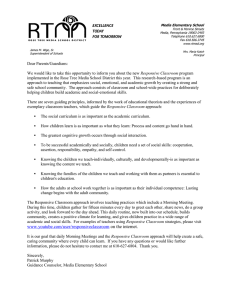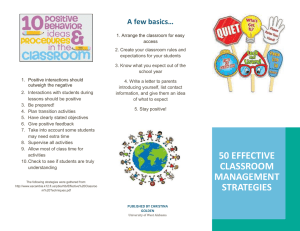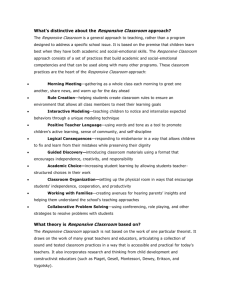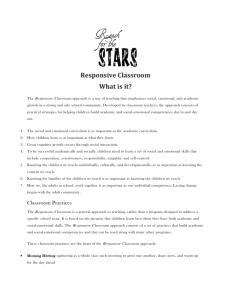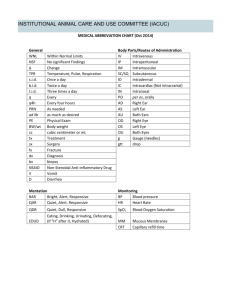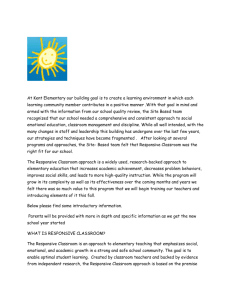Responsive Classroom ®
advertisement
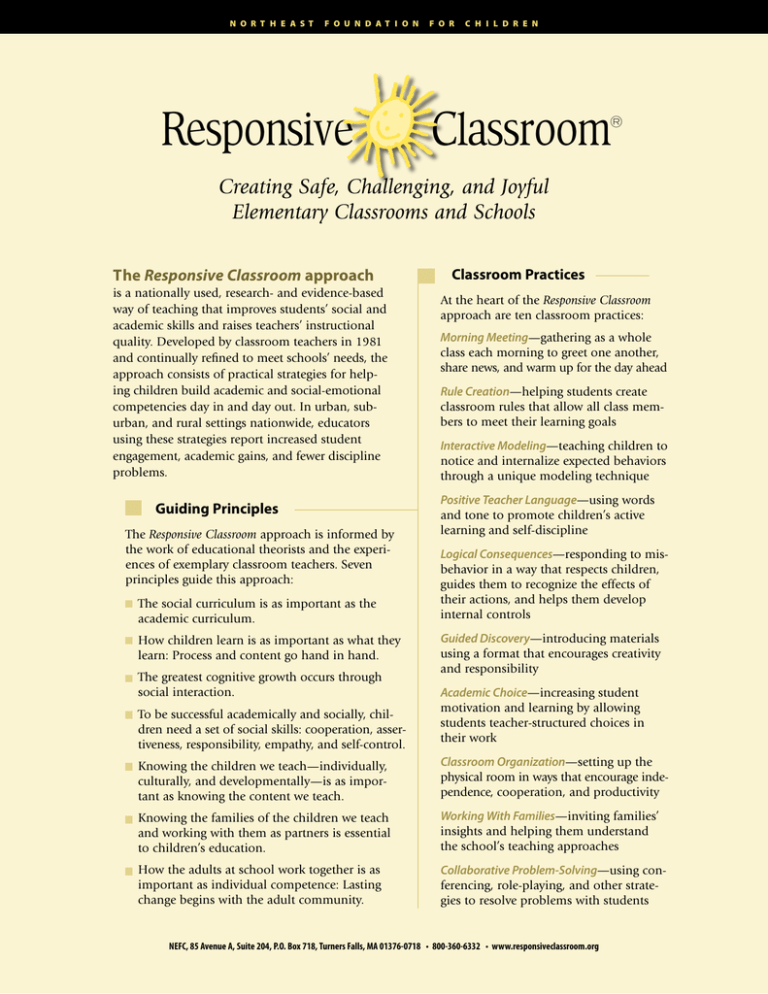
N O R T H E A ST F O U N D AT I O N Responsive F O R C H I L D R E N Classroom® Creating Safe, Challenging, and Joyful Elementary Classrooms and Schools The Responsive Classroom approach is a nationally used, research- and evidence-based way of teaching that improves students’ social and academic skills and raises teachers’ instructional quality. Developed by classroom teachers in 1981 and continually refined to meet schools’ needs, the approach consists of practical strategies for helping children build academic and social-emotional competencies day in and day out. In urban, suburban, and rural settings nationwide, educators using these strategies report increased student engagement, academic gains, and fewer discipline problems. Guiding Principles The Responsive Classroom approach is informed by the work of educational theorists and the experiences of exemplary classroom teachers. Seven principles guide this approach: The social curriculum is as important as the academic curriculum. How children learn is as important as what they learn: Process and content go hand in hand. The greatest cognitive growth occurs through social interaction. To be successful academically and socially, children need a set of social skills: cooperation, assertiveness, responsibility, empathy, and self-control. Classroom Practices At the heart of the Responsive Classroom approach are ten classroom practices: Morning Meeting—gathering as a whole class each morning to greet one another, share news, and warm up for the day ahead Rule Creation—helping students create classroom rules that allow all class members to meet their learning goals Interactive Modeling—teaching children to notice and internalize expected behaviors through a unique modeling technique Positive Teacher Language—using words and tone to promote children’s active learning and self-discipline Logical Consequences—responding to misbehavior in a way that respects children, guides them to recognize the effects of their actions, and helps them develop internal controls Guided Discovery—introducing materials using a format that encourages creativity and responsibility Academic Choice—increasing student motivation and learning by allowing students teacher-structured choices in their work Knowing the children we teach—individually, culturally, and developmentally—is as important as knowing the content we teach. Classroom Organization—setting up the physical room in ways that encourage independence, cooperation, and productivity Knowing the families of the children we teach and working with them as partners is essential to children’s education. Working With Families—inviting families’ insights and helping them understand the school’s teaching approaches How the adults at school work together is as important as individual competence: Lasting change begins with the adult community. Collaborative Problem-Solving—using conferencing, role-playing, and other strategies to resolve problems with students NEFC, 85 Avenue A, Suite 204, P.O. Box 718, Turners Falls, MA 01376-0718 • 800-360-6332 • www.responsiveclassroom.org Schoolwide Implementation In addition to incorporating Responsive Classroom practices into classroom teaching, many schools extend the principles of the approach to areas outside the classroom. They plan lunchroom and playground procedures, all-school events, and other aspects of whole-school life to ensure consistency in climate and expectations between the classroom and the larger school. Ways to Learn About the Responsive Classroom Approach Professional Development Services Introductory one-day workshops for teachers and administrators Week-long institutes offered nationwide each summer and on-site at schools Follow-up workshops and on-site consulting services to support implementation Resources for site-based study They also align school policies and procedures with Responsive Classroom philosophy and allocate resources to support Responsive Classroom implementation. Research on Effectiveness Research by the University of Virginia’s Curry School of Education has found that schools using Responsive Classroom practices see: National conference for administrators and teacher leaders Publications and Other Resources Books, DVDs, and CDs for teachers and school leaders Professional development kits for schoolbased study 1. Improved teacher-student interactions Website with extensive library of free articles: www.responsiveclassroom.org 2 . Higher-quality teaching Free newsletter for elementary educators 3. Improved social skills in children The Responsive® blog, with news, ideas, and advice from and for elementary educators 4. Greater student achievement in math and reading 5. More positive feelings toward school among children and teachers Findings are from the Social and Academic Learning Study (2001–2004) or the Responsive Classroom Efficacy Study (2008–2011), or both. For more information, go to www.responsive classroom.org/ research. Responsive About NEFC Northeast Foundation for Children, Inc. (NEFC) is a nonprofit organization and the developer and sole source provider of the Responsive Classroom approach. NEFC was founded in 1981 by four public school educators who had a vision of bringing together social and academic learning throughout the school day. Today NEFC continues to refine the Responsive Classroom approach to meet the evolving needs of students, teachers, and schools. Classroom® NORTHEAST FOUNDATION FOR CHILDREN, INC. 85 Avenue A, Suite 204, P.O. Box 718, Turners Falls, MA 01376-0718 800-360-6332 Fax 877-206-3952 www.responsiveclassroom.org
